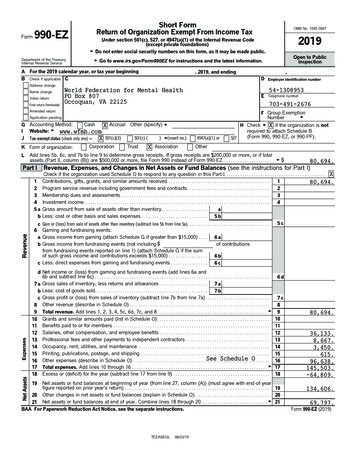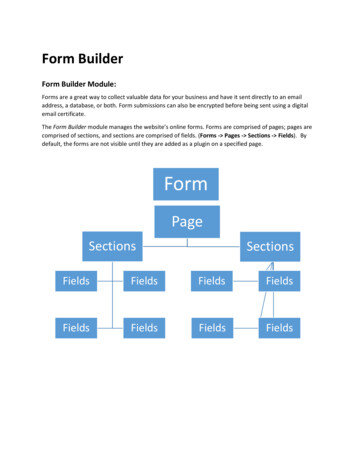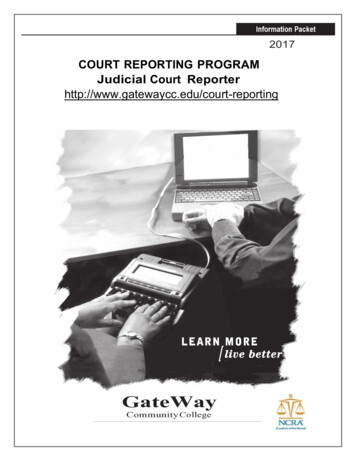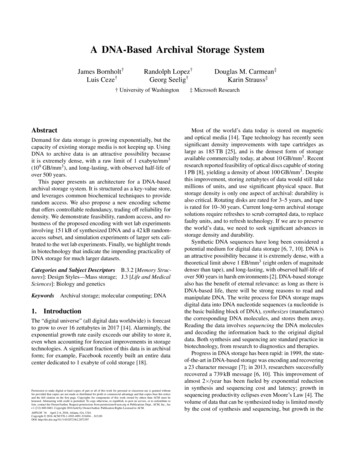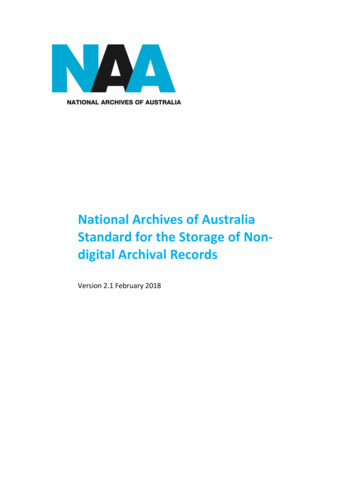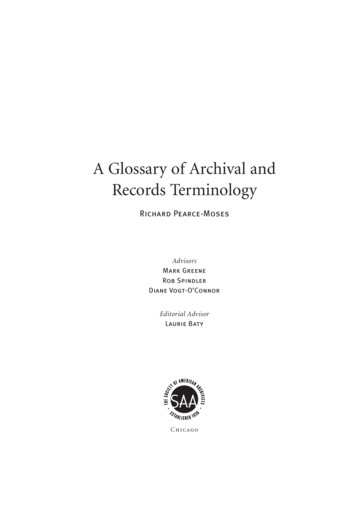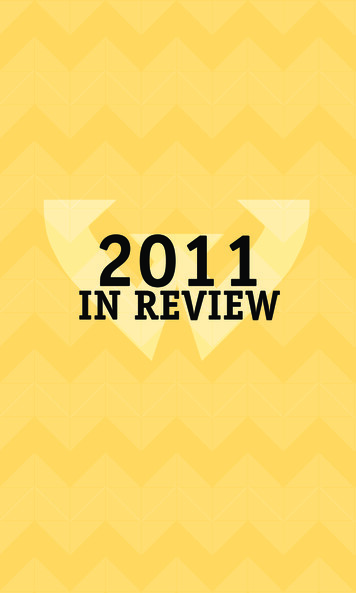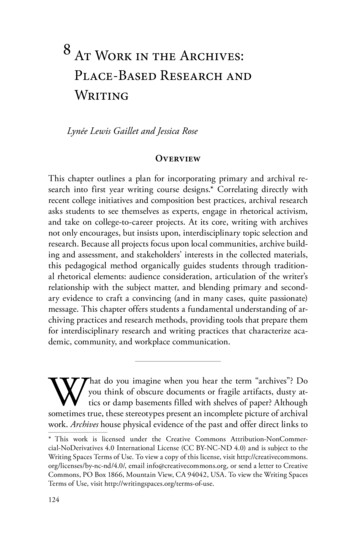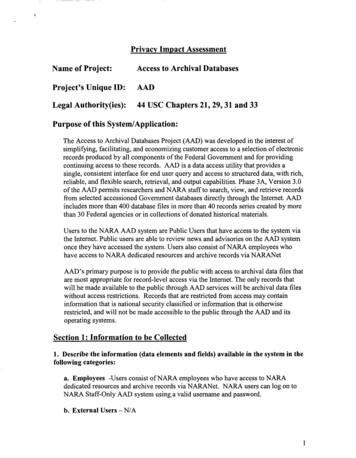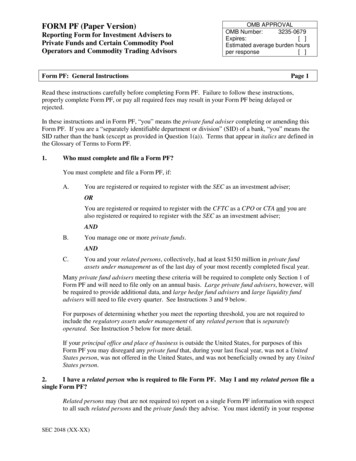
Transcription
FORM PF (Paper Version)Reporting Form for Investment Advisers toPrivate Funds and Certain Commodity PoolOperators and Commodity Trading AdvisorsOMB APPROVALOMB Number:3235-0679Expires:[ ]Estimated average burden hoursper response[ ]Form PF: General InstructionsPage 1Read these instructions carefully before completing Form PF. Failure to follow these instructions,properly complete Form PF, or pay all required fees may result in your Form PF being delayed orrejected.In these instructions and in Form PF, “you” means the private fund adviser completing or amending thisForm PF. If you are a “separately identifiable department or division” (SID) of a bank, “you” means theSID rather than the bank (except as provided in Question 1(a)). Terms that appear in italics are defined inthe Glossary of Terms to Form PF.1.Who must complete and file a Form PF?You must complete and file a Form PF, if:A.You are registered or required to register with the SEC as an investment adviser;ORYou are registered or required to register with the CFTC as a CPO or CTA and you arealso registered or required to register with the SEC as an investment adviser;ANDB.You manage one or more private funds.ANDC.You and your related persons, collectively, had at least 150 million in private fundassets under management as of the last day of your most recently completed fiscal year.Many private fund advisers meeting these criteria will be required to complete only Section 1 ofForm PF and will need to file only on an annual basis. Large private fund advisers, however, willbe required to provide additional data, and large hedge fund advisers and large liquidity fundadvisers will need to file every quarter. See Instructions 3 and 9 below.For purposes of determining whether you meet the reporting threshold, you are not required toinclude the regulatory assets under management of any related person that is separatelyoperated. See Instruction 5 below for more detail.If your principal office and place of business is outside the United States, for purposes of thisForm PF you may disregard any private fund that, during your last fiscal year, was not a UnitedStates person, was not offered in the United States, and was not beneficially owned by any UnitedStates person.2.I have a related person who is required to file Form PF. May I and my related person file asingle Form PF?Related persons may (but are not required to) report on a single Form PF information with respectto all such related persons and the private funds they advise. You must identify in your responseSEC 2048 (XX-XX)
Form PF: General InstructionsPage 2to Question 1 the related persons as to which you are reporting and, where information isrequested about you or the private funds you advise, respond as though you and such relatedpersons were one firm.3.How is Form PF organized?Section 1 – All Form PF filersSection 1aAll private fund advisers required to file Form PF must complete Section 1a.Section 1a asks general identifying information about you and the types of privatefunds you advise.Section 1bAll private fund advisers required to file Form PF must complete Section 1b.Section 1b asks for certain information regarding the private funds that youadvise.Section 1cAll private fund advisers that are required to file Form PF and advise one or morehedge funds must complete Section 1c. Section 1c asks for certain informationregarding the hedge funds that you advise.Section 2 – Large hedge fund advisersSection 2aYou are required to complete Section 2a if you and your related persons,collectively, had at least 1.5 billion in hedge fund assets under management as ofthe last day of any month in the fiscal quarter immediately preceding your mostrecently completed fiscal quarter. You are not required to include the regulatoryassets under management of any related person that is separately operated.Subject to Instruction 4, Section 2a requires information to be reported on anaggregate basis for all hedge funds that you advise.Section 2bIf you are required to complete Section 2a, you must complete a separateSection 2b with respect to each qualifying hedge fund that you advise.However:if you are reporting separately on the funds of a parallel fund structure that, in theaggregate, comprises a qualifying hedge fund, you must complete a separateSection 2b for each parallel fund that is part of that parallel fund structure (evenif that parallel fund is not itself a qualifying hedge fund); andif you report answers on an aggregated basis for any master-feeder arrangementor parallel fund structure in accordance with Instruction 5, you should onlycomplete a separate Section 2b with respect to the reporting fund for such masterfeeder arrangement or parallel fund structure.Section 3 – Large liquidity fund advisersSection 3You are required to complete Section 3 if (i) you advise one or more liquidityfunds and (ii) as of the last day of any month in the fiscal quarter immediatelypreceding your most recently completed fiscal quarter, you and your related
Form PF: General InstructionsPage 3persons, collectively, had at least 1 billion in combined money market andliquidity fund assets under management. You are not required to include theregulatory assets under management of any related person that is separatelyoperated.You must complete a separate Section 3 with respect to each liquidity fund thatyou advise.However, if you report answers on an aggregated basis for any master-feederarrangement or parallel fund structure in accordance with Instruction 5, youshould only complete a separate Section 3 with respect to the reporting fund forsuch master-feeder arrangement or parallel fund structure.Section 4 – Large private equity advisersSection 4You are required to complete Section 4 if you and your related persons,collectively, had at least 2 billion in private equity fund assets undermanagement as of the last day of your most recently completed fiscal year. Youare not required to include the regulatory assets under management of any relatedperson that is separately operated.You must complete a separate Section 4 with respect to each private equity fundthat you advise.However, if you report answers on an aggregated basis for any master-feederarrangement or parallel fund structure in accordance with Instruction 5, youshould only complete a separate Section 4 with respect to the reporting fund forsuch master-feeder arrangement or parallel fund structure.Section 5 – Advisers requesting a temporary hardship exemptionSection 5See Instruction 13 for details.4.I am a subadviser or engage a subadviser for a private fund. Who is responsible forreporting information about that private fund?Only one private fund adviser should complete and file Form PF for each private fund. If theadviser that filed Form ADV Section 7.B.1 with respect to any private fund is required to fileForm PF, the same adviser must also complete and file Form PF for that private fund. If theadviser that filed Form ADV Section 7.B.1 with respect to any private fund is not required to fileForm PF (e.g., because it is an exempt reporting adviser) and one or more other advisers to thefund is required to file Form PF, another adviser must complete and file Form PF for that privatefund.Where a question requests aggregate information regarding the private funds that you advise, youshould only include information regarding the private funds for which you are filing Section 1b ofForm PF.
Form PF: General InstructionsPage 45.When am I required to aggregate information regarding parallel funds, parallel managedaccounts, master-feeder arrangements and funds managed by related persons?You are required to aggregate related funds and accounts differently depending on the purpose ofthe aggregation.Reporting thresholds. For purposes of determining whether you meet any reporting threshold,you must aggregate parallel funds, dependent parallel managed accounts and master-feederfunds. In addition, you must treat any private fund or parallel managed account advised by anyof your related persons as though it were advised by you. You are not required, however, toaggregate private funds or parallel managed accounts of any related person that is separatelyoperated.Responding to questions. When reporting on individual funds, you may provide informationregarding master-feeder arrangements or parallel fund structures either in the aggregate orseparately, provided that you do so consistently throughout the Form. (For example, you maycomplete either a single Section 1b for all of the funds in a master-feeder arrangement or aseparate Section 1b for each fund in the arrangement, but you must then take the same approachwhen completing other applicable sections of the Form.) Where a question requests aggregateinformation regarding the private funds that you advise, you should only include informationregarding the private funds for which you are filing Section 1b of Form PF. You are not requiredto report information regarding parallel managed accounts (except in Question 11). You shouldnot report information for any private fund advised by any of your related persons unless youhave identified that related person in Question 1(b) as a related person for which you are filingForm PF.See the table below for additional details.For purposes of determining whether aprivate fund is a qualifying hedge fundFor purposes of reporting information inSections 1b, 1c, 2b, 3 and 4 You must aggregate any private funds thatare part of the same master-feederarrangement (even if you did not, or werenot permitted to, aggregate these privatefunds for purposes of Form ADV Section7.B.1) You may, but are not required to, reportanswers on an aggregated basis for anyprivate funds that are part of the samemaster-feeder arrangement (even if youdid not, or were not permitted to, aggregatethese private funds for purposes of FormADV Section 7.B.1) You must aggregate any private funds thatare part of the same parallel fund structure You may, but are not required to, reportanswers on an aggregated basis for anyprivate funds that are part of the sameparallel fund structure Any dependent parallel managed accountmust be aggregated with the largest privatefund to which that dependent parallelmanaged account relates You are not required to report informationregarding parallel managed accounts(except in Question 11)
Form PF: General Instructions You must treat any private fund or parallelmanaged account advised by any of yourrelated persons as though it were advisedby you (including related persons that youhave not identified in Question 1(b) asrelated persons for which you are filingForm PF, though you may exclude relatedpersons that are separately operated)Page 5 You should not report information for anyprivate fund advised by any of your relatedpersons unless you have identified thatrelated person in Question 1(b) as a relatedperson for which you are filing Form PF6.I am required to aggregate funds or accounts to determine whether I meet a reportingthreshold, or I am electing to aggregate funds for reporting purposes. How do I “aggregate” fundsor accounts for these purposes?Where two or more parallel funds or master-feeder funds are aggregated in accordance withInstruction 5, you must treat the aggregated funds as if they were all one private fund.Investments that a feeder fund makes in a master fund should be disregarded but otherinvestments of the feeder fund should be treated as though they were investments of theaggregated fund.Where you are aggregating dependent parallel managed accounts to determine whether you meeta reporting threshold, assets held in the accounts should be treated as assets of the private fundswith which they are aggregated.Example 1.You advise a master-feeder arrangement with one feeder fund. The feederfund has invested 500 in the master fund and holds a foreign exchangederivative with a notional value of 100. The master fund has used the 500 received from the feeder fund to invest in corporate bonds. Neitherfund has any other assets or liabilities.For purposes of determining whether the funds comprise a qualifying hedgefund, this master-feeder arrangement should be treated as a single privatefund whose only investments are 500 in corporate bonds and a foreignexchange derivative with a notional value of 100. If you elect to aggregatethe master-feeder arrangement for reporting purposes, the treatment wouldbe the same.Example 2.You advise a parallel fund structure consisting of two hedge funds, namedparallel fund A and parallel fund B. You also advise a related dependentparallel managed account. The account and each fund have invested incorporate bonds of Company X and have no other assets or liabilities. Thevalue of parallel fund A’s investment is 400, the value of parallel fund B’sinvestment is 300 and the value of the account’s investment is 200.For purposes of determining whether either of the parallel funds is aqualifying hedge fund, the entire parallel fund structure and the relateddependent parallel managed account should be treated as a single privatefund whose only asset is 900 of corporate bonds issued by Company X.If you elect to aggregate the parallel fund structure for reporting purposes,you would disregard the dependent parallel managed account, so the resultwould be a single private fund whose only asset is 700 of corporate bonds
Form PF: General InstructionsPage 6issued by Company X.7.I advise a private fund that invests in other private funds (e.g., a “fund of funds”). Howshould I treat these investments for purposes of Form PF?Investments in other private funds generally. For purposes of this Form PF, you may disregardany private fund’s equity investments in other private funds. However, if you disregard theseinvestments, you must do so consistently (e.g., do not include disregarded investments in the netasset value used for determining whether the fund is a “hedge fund”). For Question 17, even ifyou disregard these assets, you may report the performance of the entire fund and are not requiredto recalculate performance in order to exclude these investments. Do not disregard any liabilities,even if incurred in connection with these investments.Funds that invest substantially all of their assets in other private funds. If you advise a privatefund that (i) invests substantially all of its assets in the equity of private funds for which you arenot an adviser and (ii) aside from such private fund investments, holds only cash and cashequivalents and instruments acquired for the purpose of hedging currency exposure, then you areonly required to complete Section 1b for that fund. For all other purposes, you should disregardsuch fund. For example, where questions request aggregate information regarding the privatefunds you advise, do not include the assets or liabilities of any such fund.Solely for purposes of this Instruction 7, you may treat as a private fund any issuer formed underthe laws of a jurisdiction other than the United States that has not offered or sold its securities inthe United States or to United States persons but that would be a private fund if it had engaged insuch an offering or sale.Notwithstanding the foregoing, you must include disregarded assets in responding to Question 10.8.I advise a private fund that invests in companies that are not private funds. How should Itreat these investments for purposes of Form PF?Except as provided in Instruction 7, investments in funds should be included for all purposesunder this Form PF. You are not, however, required to “look through” a fund’s investments inany other entity unless the Form specifically requests information regarding that entity or theother entity’s primary purpose is to hold assets or incur leverage as part of the reporting fund’sinvestment activities.9.When am I required to update Form PF?You are required to update Form PF at the following times:Periodic filings(large hedge fundadvisers)Within 60 calendar days after the end of your first, second and third fiscalquarters, you must file a quarterly update that updates the answers to allItems in this Form PF relating to the hedge funds that you advise.Within 60 calendar days after the end of your fourth fiscal quarter, you mustfile a quarterly update that updates the answers to all Items in this Form PF.You may, however, submit an initial filing for the fourth quarter thatupdates information relating only to the hedge funds that you advise so longas you amend your Form PF within 120 calendar days after the end of thequarter to update information relating to any other private funds that you
Form PF: General InstructionsPage 7advise. When you file such an amendment, you are not required to updateinformation previously filed for such quarter.Periodic filings(large liquidityfund advisers)Within 15 calendar days after the end of your first, second and third fiscalquarters, you must file a quarterly update that updates the answers to allItems in this Form PF relating to the liquidity funds that you advise.Within 15 calendar days after the end of your fourth fiscal quarter, you mustfile a quarterly update that updates the answers to all Items in this Form PF.You may, however, submit an initial filing for the fourth quarter thatupdates information relating only to the liquidity funds that you advise solong as you amend your Form PF within 120 calendar days after the end ofthe quarter to update information relating to any other private funds that youadvise (subject to the next paragraph). When you file such an amendment,you are not required to update information previously filed for such quarter.If you are both a large liquidity fund adviser and a large hedge fundadviser, you must file your quarterly updates with respect to the liquidityfunds that you advise within 15 calendar days and with respect to the hedgefunds you advise within 60 calendar days.Periodic filingsWithin 120 calendar days after the end of your fiscal year, you must file an(all other advisers) annual update that updates the answers to all Items in this Form PF.Large hedge fund advisers and large liquidity fund advisers are not requiredto file annual updates but instead file quarterly updates for the fourthquarter.Transition filingIf you are transitioning from quarterly to annual filing because you are nolonger a large hedge fund adviser or large liquidity fund adviser, then youmust complete and file Item A of Section 1a and check the box inSection 1a indicating that you are making your final quarterly filing. Youmust file your transition filing no later than the last day on which your nextquarterly update would be timely.Final filingIf you are no longer required to file Form PF, then you must complete andfile Item A of Section 1a and check the box in Section 1a indicating thatyou are making your final filing. You must file your final filing no laterthan the last day on which your next Form PF update would be timely. Thisapplies to all Form PF filers.Failure to update your Form PF as required by these instructions is a violation of SEC and,where applicable, CFTC rules and could lead to revocation of your registration.10.How do I obtain private fund identification numbers for my reporting funds?Each private fund must have an identification number for purposes of reporting on Form ADVand Form PF. Private fund identification numbers can only be obtained by filing Form ADV.If you need to obtain a private fund identification number and you are required to file a quarterlyupdate of Form PF prior to your next annual update of Form ADV, then you must acquire the
Form PF: General InstructionsPage 8identification number by filing an other-than-annual amendment to your Form ADV andfollowing the instructions on Form ADV for generating a new number. When filing an otherthan-annual amendment for this purpose, you must complete and file all of Form ADV Section7.B.1 for the new private fund.See Instruction 6 to Part 1A of Form ADV for additional information regarding the acquisitionand use of private fund identification numbers.11.Who must sign my Form PF or update?The individual who signs the Form PF depends upon your form of organization: For a sole proprietorship, the sole proprietor.For a partnership, a general partner.For a corporation, an authorized principal officer.For a limited liability company, a managing member or authorized person.For a SID, a principal officer of your bank who is directly engaged in the management,direction or supervision of your investment advisory activities.For all others, an authorized individual who participates in managing or directing your affairs.The signature does not have to be notarized and should be a typed name.If you and one or more of your related persons are filing a single Form PF, then Form PF may besigned by one or more individuals; however, the individual, or the individuals collectively, musthave authority, as provided above, to sign both on your behalf and on behalf of all such relatedpersons.12.How do I file my Form PF?You must file Form PF electronically through the Form PF filing system on the InvestmentAdviser Registration Depository website (www.iard.com), which contains detailed filinginstructions. Questions regarding filing through the Form PF filing system should beaddressed to the Financial Industry Regulatory Authority (FINRA) at 240-386-4848.13.Are there filing fees?Yes, you must pay a filing fee for your Form PF filings. The Form PF filing fee schedule ispublished at http://www.sec.gov/iard and http://www.iard.com.14.What if I am not able to file electronically?A temporary hardship exemption is available if you encounter unanticipated technical difficultiesthat prevent you from making a timely filing with the Form PF filing system, such as a computermalfunction or electrical outage. This exemption does not permit you to file on paper; instead, itextends the deadline for an electronic filing for seven “business days” (as such term is used inSEC rule 204(b)-1(f)).To request a temporary hardship exemption, you must complete and file on paper Item A ofSection 1a and Section 5 of Form PF, checking the box in Section 1a indicating that you arerequesting a temporary hardship exemption. Mail one manually signed original and one copy ofyour exemption filing to: U.S. Securities and Exchange Commission, Branch of Regulations and
Form PF: General InstructionsPage 9Examinations, Mail Stop 0-25, 100 F Street NE, Washington, DC 20549. You must preserve inyour records a copy of any temporary hardship exemption filing. Any request for a temporaryhardship exemption must be filed no later than one business day after the electronic Form PFfiling was due. For more information, see SEC rule 204(b)-1(f).15.May I rely on my own methodologies in responding to Form PF? How should I enterrequested information?You may respond to this Form using your own internal methodologies and the conventions ofyour service providers, provided the information is consistent with information that you reportinternally and to current and prospective investors. However, your methodologies must beconsistently applied and your responses must be consistent with any instructions or otherguidance relating to this Form. You may explain any of your methodologies, including relatedassumptions, in Question 4.In responding to Questions on this Form, the following guidelines apply unless otherwisespecifically indicated: provide the requested information as of the close of business on the data reporting date; if information is requested for any month or quarter, provide the requested information as ofthe close of business on the last calendar day of the month or quarter, respectively; if a question requests information expressed as a percentage, enter the response as apercentage (not a decimal) and round to the nearest one percent; if a question requests a monetary value, provide the information in U.S. dollars as of the datareporting date, rounded to the nearest thousand; if a question requests a numerical value other than a percentage or a dollar value, provideinformation rounded to the nearest whole number; if a question requests information regarding a “position” or “positions,” you should determinewhether a set of legal and contractual rights constitutes a “position” in a manner consistentwith your internal recordkeeping and risk management procedures (e.g., some advisers mayrecord as a single position two or more partially offsetting legs of a transaction entered intowith the same counterparty under the same master agreement, while others may record theseas separate positions); if a question requires you to distinguish long positions from short positions, classify positionsin a manner consistent with your internal recordkeeping and risk management procedures(provided that, for CDS, exotic CDS, index CDS, and single name CDS, the protection sellershould be viewed as long and the protection buyer should be viewed as short); do not net long and short positions; for derivatives (other than options), “value” means gross notional value; for options, “value”means delta adjusted notional value; for all other investments and for all borrowings wherethe reporting fund is the creditor, “value” means market value or, where there is not a readilyavailable market value, fair value; for borrowings where the reporting fund is the debtor,“value” means the value you report internally and to current and prospective investors; and
Form PF: General Instructions 16.Page 10for questions 20, 21, 25, 28, 35 and 57, the numerator you use to determine the percentage ofnet asset value should be measured on the same basis as gross asset value and may result inresponses that total more than 100%.How do I amend Form PF, for example, to make a correction?If you discover that information you filed on Form PF was not accurate at the time of filing, youmay correct the information by re-filing and checking the box in Section 1a indicating that youare amending a previously submitted filing. You are not required to update information that youbelieve in good faith properly responded to Form PF on the date of filing even if that informationis subsequently revised for purposes of your recordkeeping, risk management or investorreporting (such as estimates that are refined after completion of a subsequent audit).Large hedge fund advisers and large liquidity fund advisers that comply with their fourth quarterfiling obligations by submitting an initial filing followed by an amendment in accordance withInstruction 9 will not be viewed as affirming responses regarding one fund solely by providingupdated information regarding another fund at a later date.17.How may I preserve on Form PF the anonymity of a private fund that I advise?If you seek to preserve the anonymity of a private fund that you advise by maintaining its identityin your books and records in numerical or alphabetical code, or similar designation, pursuant torule 204-2(d), you may identify the private fund on Form PF using the same code or designationin place of the fund’s name.18.May I report on Form PF regarding a commodity pool that is not a private fund? Howshould I treat the commodity pool for purposes of Form PF?If you are otherwise required to report on Form PF, you may report information regarding anycommodity pool you advise on Form PF, even if it is not a private fund. Properly reporting onForm PF regarding the commodity pool will constitute substitute compliance with CFTCreporting requirements to the extent provided in CEA rule 4.27.Commodity pools should be treated as hedge funds for purposes of Form PF. If you are reportingon Form PF regarding a commodity pool that is not a private fund, then treat it as a private fundfor purposes of Form PF. However, such a commodity pool is not required to be included whendetermining whether you exceed one or more reporting thresholds. If such a commodity pool is aqualifying hedge fund and you are otherwise required to report information in section 2a ofForm PF, then you must report regarding the commodity pool in section 2b of Form PF.Federal Information Law and Requirements for a Collection of InformationSection 204(b) of the Advisers Act [15 U.S.C. § 80b-4(b)] authorizes the SEC to collect the informationthat Form PF requires. The information collected on Form PF is designed to facilitate the FinancialStability Oversight Council’s (“FSOC”) monitoring of systemic risk in the private fund industry and toassist FSOC in determining whether and how to deploy its regulatory tools with respect to nonbankfinancial companies. The SEC and CFTC may also use information collected on Form PF in theirregulatory programs, including examinations, investigations and investor protection efforts relating toprivate fund advisers. Filing Form PF is mandatory for advisers that satisfy the criteria described in
Form PF: General InstructionsPage 11Instruction 1 to the Form. See also 17 C.F.R. § 275.204(b)-1. The SEC does not intend to make publicinformation reported on Form PF that is identifiable to any particular adviser or private fund, although theSEC may use Form PF information in an enforcement action. See Section 204(b) of the Advisers Act.An agency may not conduct or sponsor, and a person is not required to respond to, a collection ofinformation unless it displays a currently valid control number. The Office of Management and Budgethas reviewed this collection of information under 44 U.S.C. § 3507. Any member of the public maydirect any comments concerning the accuracy of the burden estimate and any suggestion for reducing thisburden to: Secretary, U.S. Securities and Exchange Commission, 100 F Street NE, Washington, DC20549.
Form PFSection 1aInformation about you and your related persons(to be completed by all Form PF filers)Page 1 of 42Section 1a: Information about you and your related personsCheck the box that indic
Section 1 - All Form PF filers Section 1a All private fund adviser s required to file Form PF must complete Section 1a. Section 1a asks general identifying information about you and the types of private funds you advise. Section 1b All private fund adviser s required to file Form PF must complete Section 1b. Section 1b asks for certain information regarding the private funds that you
